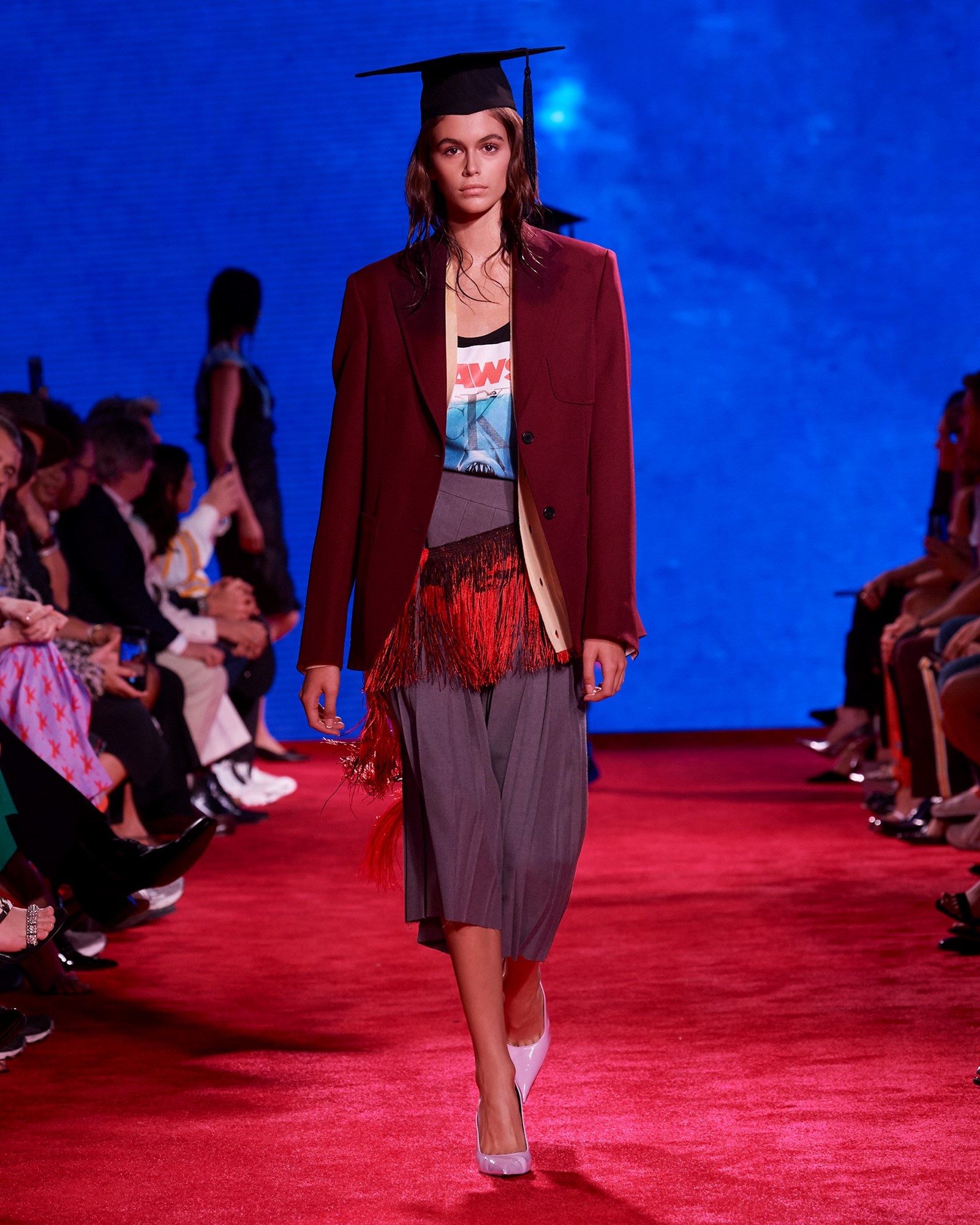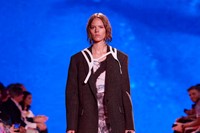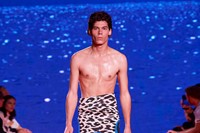Is it inevitable that, as borders are thrown up around the world, limiting movement and emphasising individual sovereignty, fashion designers would react by examining their own sense of self, of what their labels stand for on a global stage? It’s just been reiterated by Riccardo Tisci at Burberry with his aesthetic ode to a United Kingdom, underscoring his designs with a distinct British sartorial vernacular. Although, far from Brexit exits, his clothes emphasised a notion of togetherness – he called the show “Kingdom”, perhaps indicating that the “United” is implicit. More humorously, his models emerged with pochettes dangling from lanyards around their necks mocked up to resemble passport covers. They were the European Union burgundy, not the blue that many have tub-thumped as a return to Gloriana days, and others decried as symbolic of Little England.
That’s because fashion designers do not – indeed, cannot – view the world with parochial eyes. They have to examine the big picture, even if simultaneously reinforcing brand values via a national identity. Local and global, here and there. It’s a tough call, and one only the very best are nailing with alacrity. Example: Jack McCollough and Lazaro Hernandez returned to New York for the Spring/Summer 2019 season, after a two-season stint in Paris, coinciding with the launch of their first fragrance with L’Oreal. Their clothes were, perhaps inevitably, infused with the attitude of their adopted city, and a certain wide-eyed, distanced appreciation – corded laces, floral prints, feathers, embroideries, a riff on Yves Saint Laurent’s 1940s collection. A couple of American boys, showing their appreciation for couture. Back in New York, McCollough and Hernandez showed in a blown-out former Wall Street office, jostling against the 71-storey Trump Building at number 40. Can’t get more American than that. Nor can you get more American than these clothes, in bleached-out and washed denim, part Claire McCardell – the post-war American fashion designer who put women in denim and cotton shirtwaist dresses that still look modern today – part Marlon Brando with its intentionally distressed and worn feel. The strongly-curved shoulders and bouncing skirts lent them a dynamic movement. They felt young, and powerful. Just like the New World.
McCollough and Hernandez grew up in America, of course, both in their lives and in fashion terms. Raf Simons is a more recent addition, at Calvin Klein, which doesn’t make his adopting of American styles and signifiers less authentic or real, just different. Its also a dynamic influence – Simons’ view of America is, ironically, helping to shape and shift US fashion as a whole right now. Simons has been enthralled by American culture throughout his life; his collections have frequently referenced America, drawing from youth cults and subcultures, from mass media, from the contemporary art world, from fashion magazines and past designers. His menswear has elevated the all-American sweatshirt into an art form, using it as a palimpsest for teenage-style protest and aggression, and a canvas for new ideas, directly expressed. He has created a collection in unique co-named collaboration with the Californian artist Sterling Ruby, and used his clothes as a kind of ‘gallery’ to frame an ‘exhibition’ of archival images by the late American photographer Robert Mapplethorpe. Mapplethorpe’s work – contrasting portraits of the beautiful, influential and moneyed with images so sexually explicit they have been banned in many countries, including the United States – is fundamentally American, exploring the country’s prurient fascinations with sex (obviously) and money, as well as status. Mapplethorpe turned a camera onto his own obsessions, which were, in turn, America’s. And Mapplethorpe is an obsession of Simons.
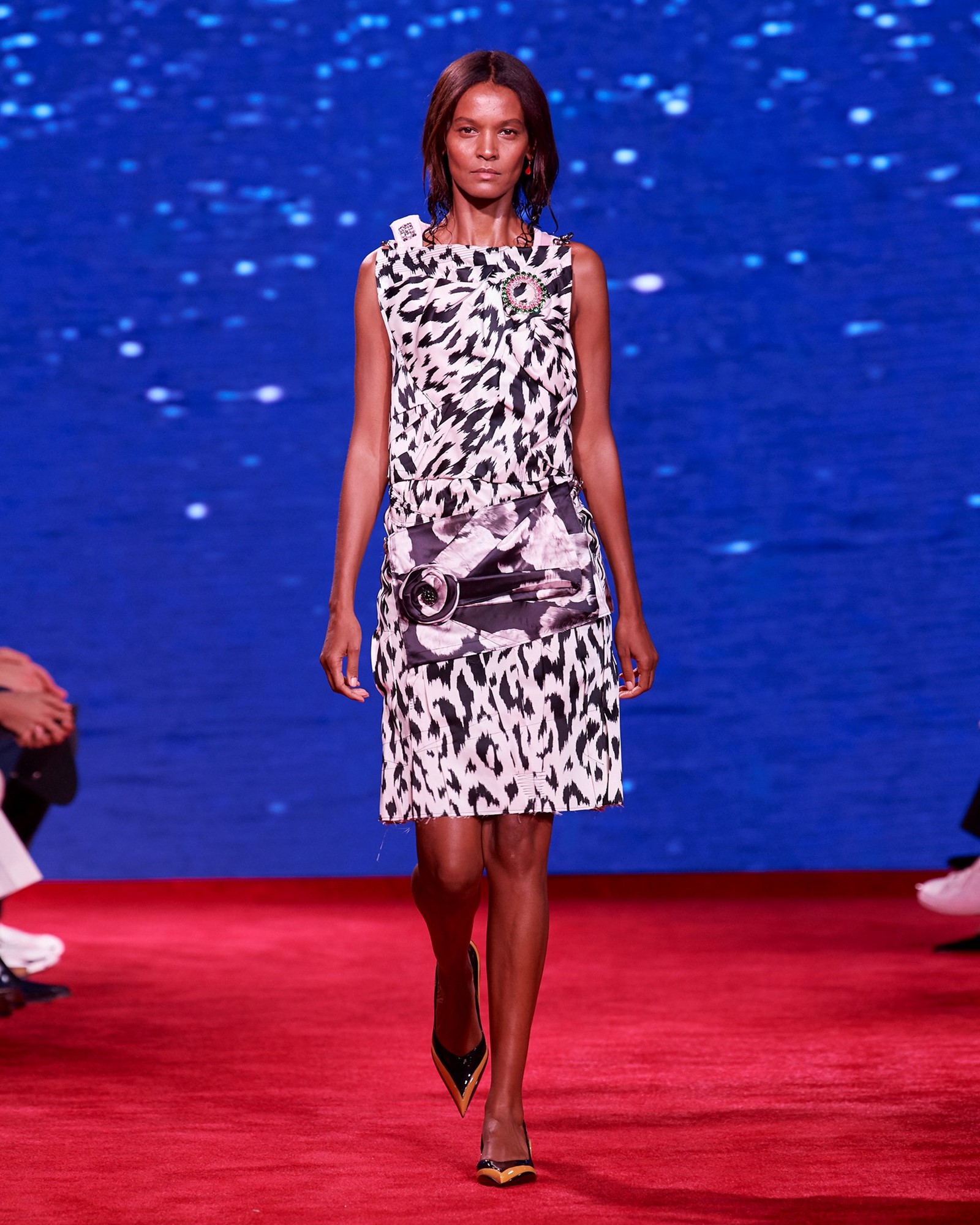

Those examples chart Raf Simons’ extensive fascination with America under his eponymous line: he’s explored it in his work for others, too. His forays into mid-century couture, at both Jil Sander and, later, Christian Dior, often reflected an American rather than a European tradition. “I hate the feeling of a guy supporting [a girl] on a staircase,” Simons bemoaned in Dior and I, the documentary charting the preparations behind his debut haute couture collection for that house. Which, oddly enough, is very much an American sensibility – an ease of movement, a casual attitude. It’s something that has infused Simons’ womenswear, where a ball skirt could be combined with a white T-shirt, or an embroidered evening dress is sliced at mid-thigh and worn with cigarette trousers. Call it ‘Coney Island Couture’, but what it actually means is modernity, reality, a sense of sportswear infiltrating every aspect of the design process. Arguably, it reflects menswear rather than womenswear – tailoring hugging rather than gripping the body, waists defined through cut rather than corsetry, shoes you can move in. Freedom, that most American of nouns.
So, Raf Simons has been designing with that American mindset for some time. Since his tenure began at Calvin Klein, however, what Raf Simons has been asking – inquisitively, insistently – is simple: what is America today? And how do you reflect that in clothing and advertising, and fragrance, the whole architecture of a multi-billion dollar brand like Calvin Klein? It’s an interesting and very relevant consideration, in the landscape of fashion’s great movers and shakers today. Simons has described his Calvin Klein collections as about “the landscape of America – literal and psychological”. Which begs the question: if you roam America, and explore, what do you boil it all down to? How about denim and dreams? (Which isn’t a Dolly Parton song.) The two have been ever-present, often simultaneously, in his collection, combining pragmatism with fly-by-the-seat-of-your-pants fantasy. The American Dream of course isn’t necessarily light-hearted – the ending is usually happy, but the road to get there isn’t always yellow brick.
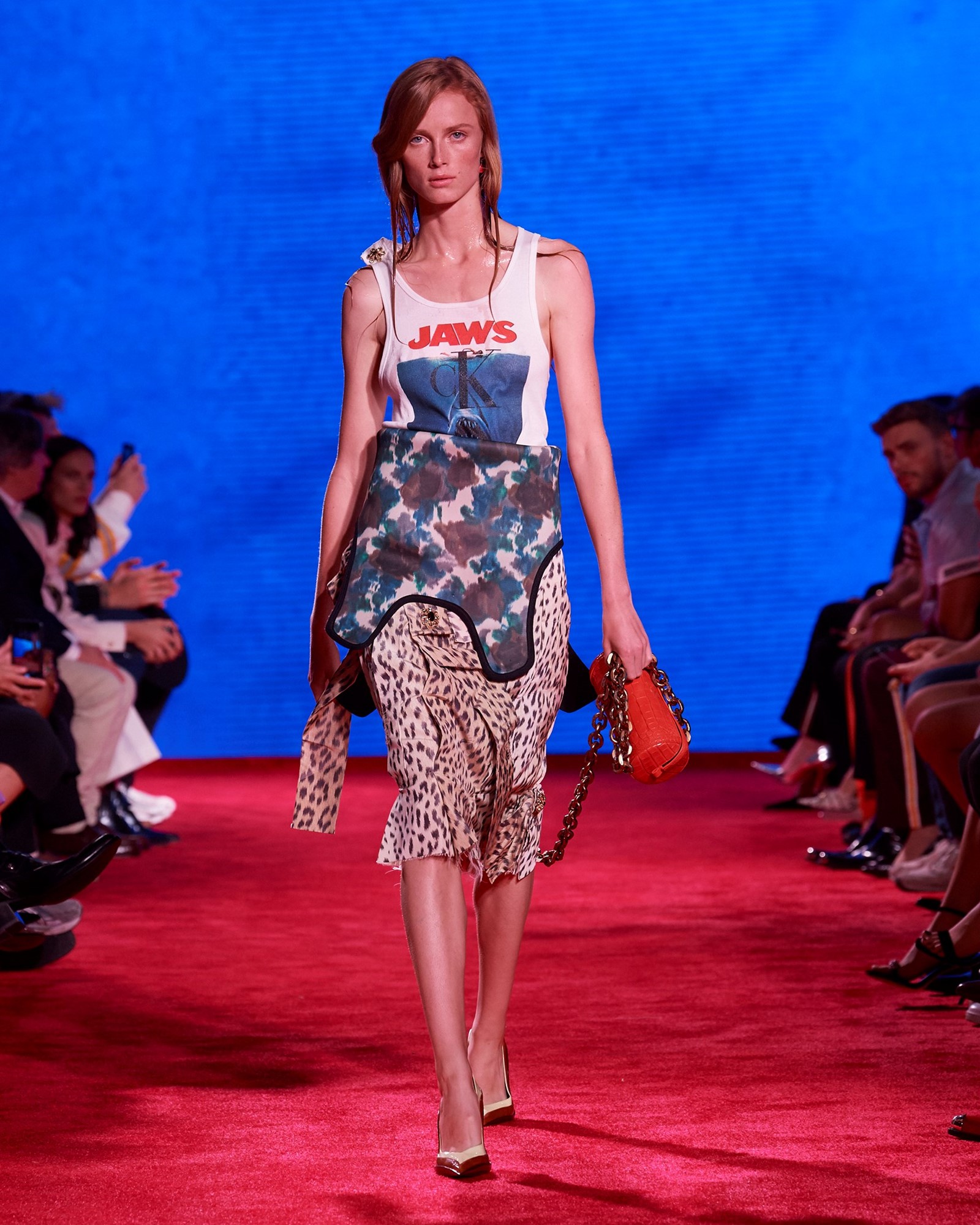
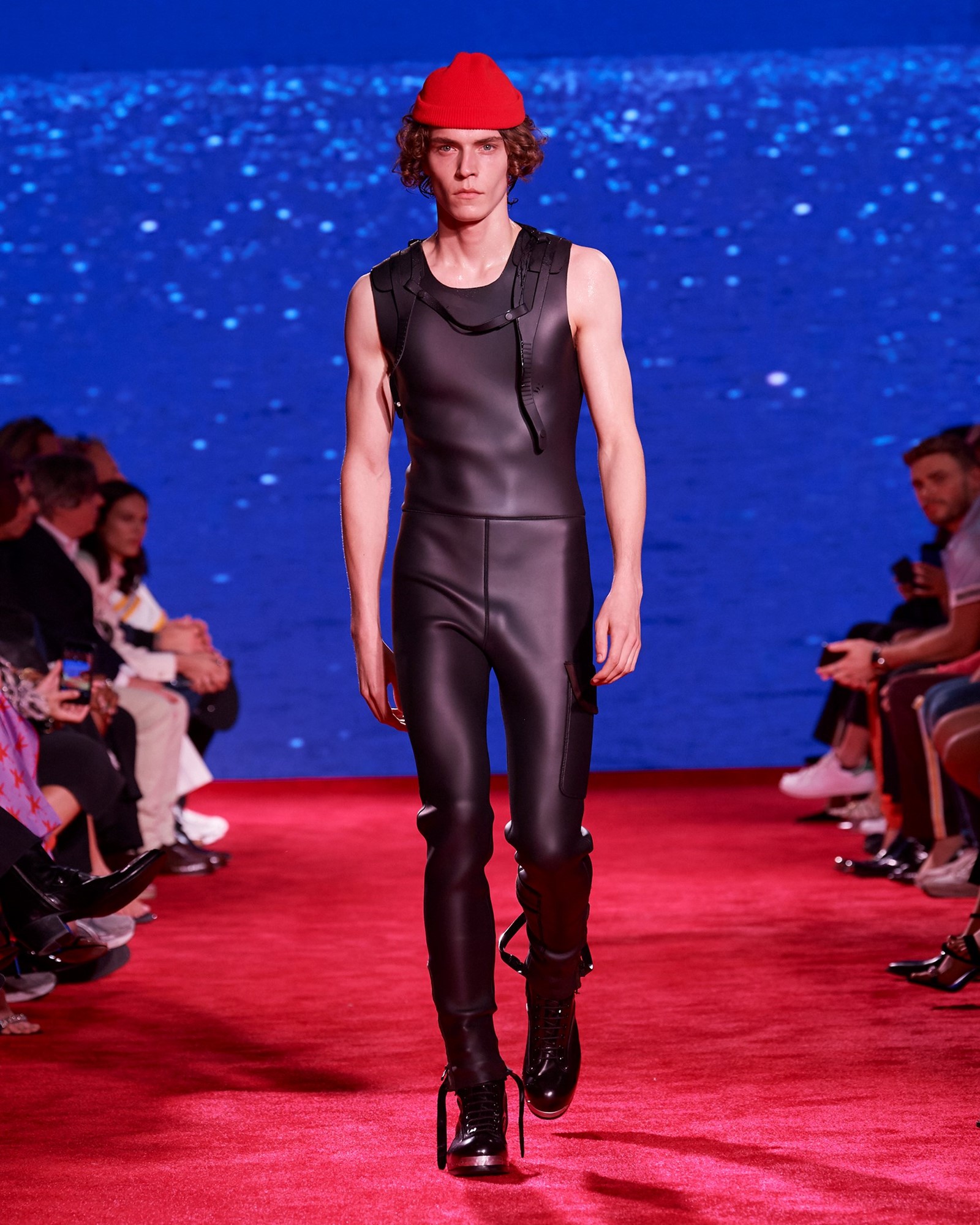
Like most of the rest of the world, Simons has primarily experienced America through movies – his vision for Klein is cinematic, panoramic, big screen. Thinking back to the most recent showing by Simons, for Spring/Summer 2019, it was a mash-up of two entirely disparate, different movies – Jaws (1975) and The Graduate (1967). The former is, of course, a horror, but Simons read it as about temptation, the tantalising risk under a placid surface. It’s the same with The Graduate. On purely aesthetic terms, they are also connected through clothing – the diving suit, which Dustin Hoffman sports in the family pool and which underscore the aquatic seascapes that, of course, dominate Jaws. They also dominated Calvin Klein’s showspace on 39th Street, azure plains bubbling in the background, as models strode out with wet hair, diving suits peeled down.
The silhouette this time was streamlined, cleaved in wetsuit-close, rather than the oversized shapes Simons has used thus far. It was a shift in his Klein concepts of America, possibly from a brawny, wide-shouldered heft evocative of the immediate post-war years, to a slimmer, 1960s lines. “I’ve always been fascinated by the dress codes of different generations – of mothers and daughters, fathers and sons; how the changes between different generations of families reflect the changes of American society,” Simons said – here, we saw the 1950s slide into the 1960s, and the generational shift of teenagers no longer emulating their parents, but rebelling. That was most intriguingly expressed in a series of complex dresses that seemed to crush the volumes of mid-century couture gowns into brief, sharp shifts, their surfaces rippling with smashed-together frills and furbelows. As if a girl moulded her mother’s dress to the shape of a new generation.
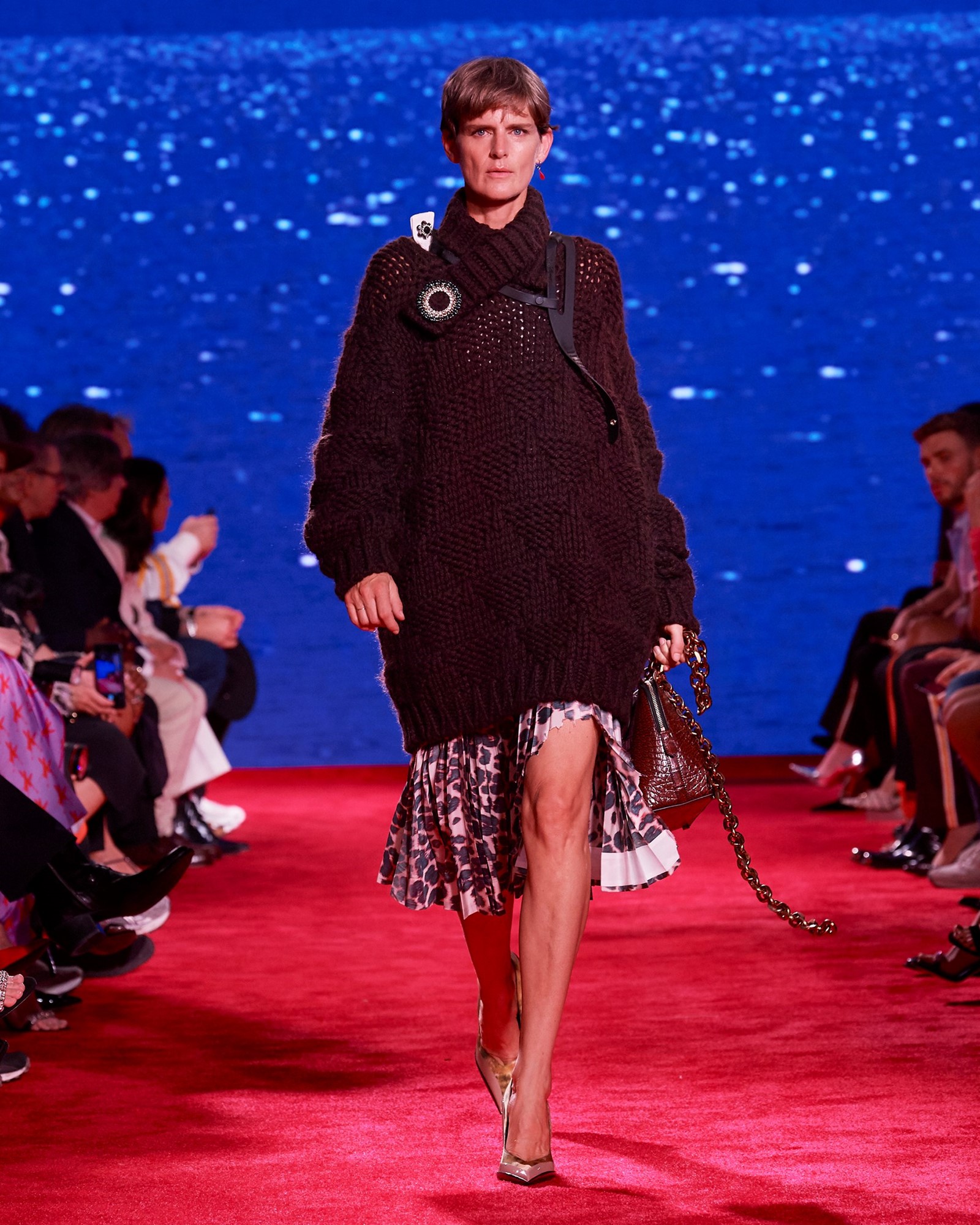
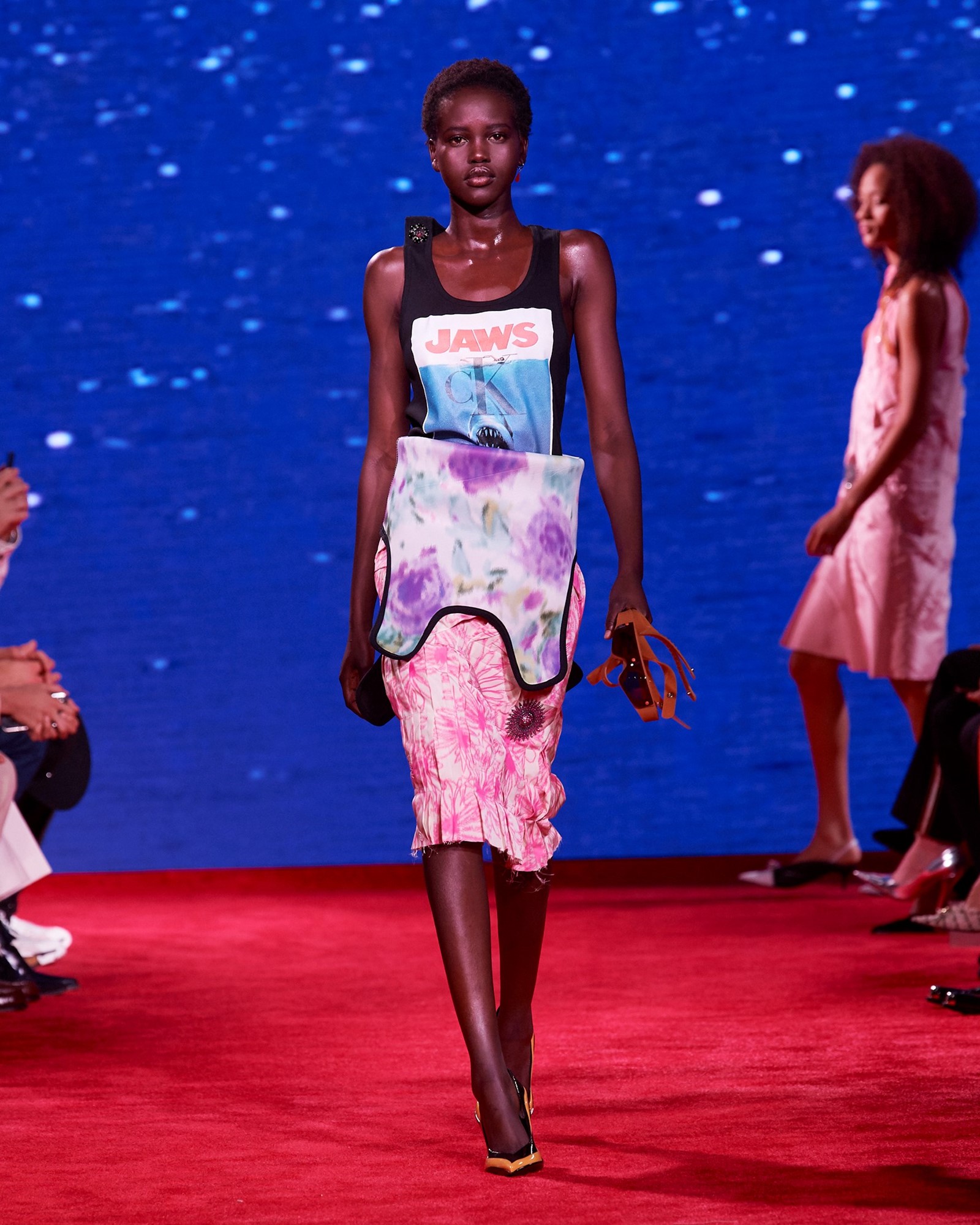
You saw that idea of reshaping, stripping, shifting, layers time and time again in this Calvin Klein collection. The interior of those diving suits were lined in chiné silks, precisely recreated by companies from the mid-century originals used for WASP-y, bubbly cocktail dresses. Sometimes, they were stripped down over a cotton tank top printed with the Jaws movie poster; occasionally, they bottomed graduation hats and robes, like multiple identities – different Americas – colliding in a single outfit. The message, however, was positive – athletic, young, joyous. All the positivity of America.
Jeans appeared on the catwalk – they always do at Simons’ Calvin Klein. No garment is more fundamentally American; and none lesser than Yves Saint Laurent once stated: “I have often said that I wish I had invented blue jeans: the most spectacular, the most practical, the most relaxed and nonchalant. They have expression, modesty, sex appeal, simplicity – all I hope for in my clothes.” The same is undoubtedly true of Simons, and his clothes. If they’re not actually jeans, they have all that attitude, and more. A jean spirit; an American soul. Simons has spoken to me about his love of democratic clothing – clothing stripped of hierarchy so, say, a diving suit can be equal to a business suit, maybe replacing one, maybe mixed with it. That’s fundamentally American too and tied again with that idea of freedom. It frees a designer to experiment, to create, to innovate. And it frees us to enjoy them.
Freedom of movement. That’s what fashion should be about.
